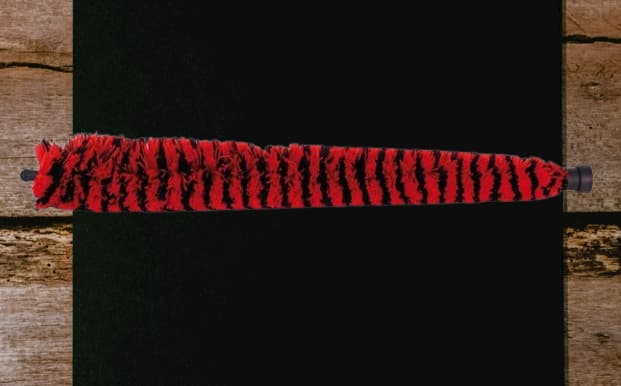If you are looking at saxophones, you have probably seen these brightly colored fluffy rods that also make great lightsaber fights.
What is the deal with these? Are they good for your sax? What are these rods?
These are referred to as saxophone pad savers.
The idea is that you put the pad saver in the saxophone, and it collects the moisture.

My Experience With Pad Savers
I’ll share some of my personal history with these.
Growing up in the 1990s, these pad savers were hot as the “new” thing.
Band directors were getting them for their instruments, music stores were promoting them, and a pad saver was even used in the movie “Bird” about famous saxophone player Charlie Parker, even though he probably never used one.
I continued on my professional career using pad savers for many years, until I found myself in Buenos Aires, Argentina, and sent my sax to be repaired. The repairman told me to stop using a pad saver immediately, as it would damage the pads.
What?!?!?!
I had been using them for years, and I had seen some professionals using them. But doing some research, I began to agree with him.
Saxophone Pads
Saxophone pads are generally made of leather, and just like any leather, moisture changes the consistency.
If the pads are constantly being bombarded with moisture, they will become stiff and won’t conform well to the key holes of the sax.
Also, mold is very bad for the saxophone pads, causing them to deteriorate.
What’s Wrong With Pad Savers?
The problem with saxophone pad savers is threefold.
One is that they collect lint. They resemble too well a dust broom and attract lint as such.
The other problem is that while they are marketed as a pad saver if you leave the pad saver in the saxophone, the moisture also stays in the sax. The pads need to dry after you play them. If they remain wet, that leads the pads to get out of form, and quickly leads to leaks and mold.
Finally, pieces of the material from the pad saver can fall off inside the saxophone, especially from cheaper pad savers.
Swabs
The old standby for saxophone cleaning is the swab.

Growing up, I had seen many older musicians use these, but these seemed super impractical because they were often made of silk or nylon and I didn’t understand how that would possibly clean the sax well with such a thin cloth.
Also, it took time to swab out the saxophone, which as a kid I really had no interest in this.
Finally, pad savers were much more fun and were perfectly designed for lightsaber battles with my friends before and after band practice.
So what to do?
Recommendations When Opting for a Pad Saver
For beginners or children just starting out, a saxophone pad saver may be easier to remember and require less discipline.
I have a couple of recommendations.
Best Sax Pad Saver
First, if you are going to use a saxophone pad saver, don’t go cheap. A cheap pad saver will be more inclined to collect lint and leave material inside the saxophone.
I recommend HW pad savers, as they have a great reputation and are the originators of the pad saver.
Check them out on Amazon:
Never Leave the Pad Saver in the Sax
Second, very important, do not leave the pad saver in the saxophone.
If you leave the pad saver inside the saxophone, the moisture will stay inside the sax, which is exactly the opposite of what you want. You want the moisture to leave.
If you use a pad saver, leave it in for maybe 5-10 minutes, then take it out. Make sure to store it somewhere where it will not easily collect lint.
You may also want to clean it, get it wet and let it dry, or clean it with a towel.
Recommendations If Opting for a Swab
A swab is also a great option if you are dedicated enough to swab it out after every use.
For the advancing player, I would absolutely recommend a swab over a pad saver. The problem is the design of so many traditional swabs is that they are made of nylon or silk and don’t take out much moisture.
I have a recommendation to address this: Bambu saxophone swabs.
Bambu Saxophone Swabs
The repairman in Argentina sold me this, and I have to reluctantly admit that it works incredibly well.

I swab out my alto sax every day with the Bambu swab, and it has been 5 years since I’ve had to do any kind of maintenance on the sax.
It collects moisture very well as it’s made of thick cloth.
Warning: Bambu swabs have a tendency once a while to get stuck in the sax. This is annoying, but I have been able to use a metal rod to get it unstuck.
If you want to look at other swab alternatives and brands, there are many different options on Amazon.
Try to get one that is made of a thicker material than the silk or nylon that is often used in swabs.
Combination Pad Saver and Swab
Also, another option is to use both pad saver and swab for a full cleaning experience.
Use the pad saver to soak up moisture, for a few minutes, then use the swab to clean the inside. However, this might be more work than many players want to do.
Final Advice
If you are using a pad saver, it’s ok. They can be effective as long as you don’t leave them inside the sax. They are also potentially a bit less work than a swab.
However, if you are an advancing player, my recommendation is to try to get a high-quality swab like Bambu. This is going to keep the sax clean and dry, and should keep your sax from having to take too many trips to the repair shop.

Author: Cooper White
- Cooper is a Multi-Instrumentalist, with vast knowledge and experience performing with Sax, Flute, Clarinet, Keyboard, and Blues Harmonica.
- With a Bachelor’s Degree from the Berklee College of Music in Boston and studies in Classical Performance at the Lionel Hampton School of Music, he has also more than 10 years of performing professionally, whether while road touring in the U.S. or playing on different cruise ships.
- He is also an entertainer with his shows, as well as a producer of his music and others. Whenever he is not performing, he teaches individual online classes. He mostly plays Jazz, Classical and Popular music.
